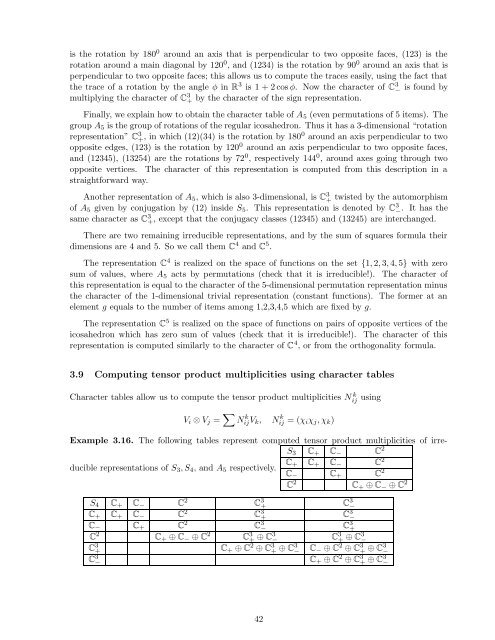Lecture notes for Introduction to Representation Theory
Lecture notes for Introduction to Representation Theory
Lecture notes for Introduction to Representation Theory
You also want an ePaper? Increase the reach of your titles
YUMPU automatically turns print PDFs into web optimized ePapers that Google loves.
is the rotation by 180 0 around an axis that is perpendicular <strong>to</strong> two opposite faces, (123) is the<br />
rotation around a main diagonal by 120 0 , and (1234) is the rotation by 90 0 around an axis that is<br />
perpendicular <strong>to</strong> two opposite faces; this allows us <strong>to</strong> compute the traces easily, using the fact that<br />
the trace of a rotation by the angle θ in R 3 is 1 + 2 cos θ. Now the character of C 3<br />
− is found by<br />
multiplying the character of C 3 by the character of the sign representation.<br />
+<br />
Finally, we explain how <strong>to</strong> obtain the character table of A 5 (even permutations of 5 items). The<br />
group A 5 is the group of rotations of the regular icosahedron. Thus it has a 3-dimensional “rotation<br />
representation” C 3 + , in which (12)(34) is the rotation by 180 0 around an axis perpendicular <strong>to</strong> two<br />
opposite edges, (123) is the rotation by 120 0 around an axis perpendicular <strong>to</strong> two opposite faces,<br />
and (12345), (13254) are the rotations by 72 0 , respectively 144 0 , around axes going through two<br />
opposite vertices. The character of this representation is computed from this description in a<br />
straight<strong>for</strong>ward way.<br />
Another representation of A 5 , which is also 3-dimensional, is C 3 + twisted by the au<strong>to</strong>morphism<br />
of A This representation is denoted by C 3<br />
5 given by conjugation by (12) inside S 5 .<br />
−. It has the<br />
same character as C 3 , except that the conjugacy classes (12345) and (13245) are interchanged.<br />
+<br />
There are two remaining irreducible representations, and by the sum of squares <strong>for</strong>mula their<br />
dimensions are 4 and 5. So we call them C 4 and C 5 .<br />
The representation C 4 is realized on the space of functions on the set {1, 2, 3, 4, 5} with zero<br />
sum of values, where A 5 acts by permutations (check that it is irreducible!). The character of<br />
this representation is equal <strong>to</strong> the character of the 5-dimensional permutation representation minus<br />
the character of the 1-dimensional trivial representation (constant functions). The <strong>for</strong>mer at an<br />
element g equals <strong>to</strong> the number of items among 1,2,3,4,5 which are fixed by g.<br />
The representation C 5 is realized on the space of functions on pairs of opposite vertices of the<br />
icosahedron which has zero sum of values (check that it is irreducible!). The character of this<br />
representation is computed similarly <strong>to</strong> the character of C 4 , or from the orthogonality <strong>for</strong>mula.<br />
3.9 Computing tensor product multiplicities using character tables<br />
Character tables allow us <strong>to</strong> compute the tensor product multiplicities N ij<br />
k<br />
using<br />
V i V j = N ij<br />
k<br />
V k , N ij<br />
k<br />
= (ν i ν j , ν k )<br />
Example 3.16. The following tables represent computed tensor product multiplicities of irre<br />
S C 2<br />
3 C + C −<br />
C − C 2<br />
+ C + C<br />
ducible representations of S 3 , S 4 , and A 5 respectively.<br />
C−<br />
C + C 2<br />
C 2 C + C − C 2<br />
S C 2 C 3<br />
C3<br />
4 C + C − +<br />
−<br />
C 2 C 3<br />
C +<br />
C 3<br />
+ C + C −<br />
−<br />
C C + C 2 3<br />
C 3<br />
− C −<br />
+<br />
C 2<br />
C C2 C3 C3<br />
− + −<br />
C<br />
C 3<br />
C C3<br />
+<br />
+ 3<br />
+ 3 C 3<br />
+ C<br />
−<br />
C<br />
3<br />
−<br />
C C<br />
C−<br />
3 + 3<br />
+ C 2 C− C 2<br />
−<br />
C + C−<br />
3<br />
+ C 2 C 3<br />
42

















